Mouse lemurs — a model in the wild
Tens of millions of years ago, possum-like Ur-mammals roamed supercontinents and fed milk to their Ur-children. As evolution tinkered over millions of subsequent lifespans, these mammals’ descendants branched out and gave rise to the taxonomic class that counts several species of bats, bears, whales, rodents and primates among its members. One branch from our ancestral primates eventually gave rise to the diverse lemurs of Madagascar, ranging from the cat-size sifaka to the palm-size mouse lemur.
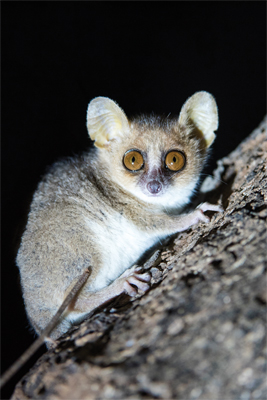
Far from an adorably nightmarish chimera of its namesakes, a mouse lemur is a lemur that’s about twice the size of a standard mouse. Like its more famous ring-tailed and red-ruffed cousins, the mouse lemur is a primate found only on Madagascar, an island nation slightly larger than France that sits off the southeast coast of Tanzania. More closely related to humans than to mice, the pint-size prosimian is possessed of a prolific nature and a similarity to humans that make it a near-perfect organism to revolutionize the study of many human diseases, experts say.
This is the goal that Mark Krasnow, a biochemist at Stanford University, and a consortium of biochemists, ecologists, conservationists, evolutionary biologists and high school students have pursued in their efforts to identify a new model organism for the study of human biology and disease and catalogue its physical traits and underlying genetics without the large-scale sacrifice and expense that mouse models require.
Musculus displaced
Climate change and human encroachment have endangered the rainforests of Madagascar, but within and without that habitat, mouse lemurs are one of the country’s most abundant species, with numbers in the millions.
“They are the rodents of Madagascar, essentially,” said Krasnow, who has spent decades puzzling out the activity of genes in animal models such as Drosophila and M. musculus, commonly known as fruit flies and laboratory mice, respectively. “They’re everywhere, in virtually every habitat.”
 The rainforests of Ramonafana National Park are home to several species of lemurs. At right is Sarah Zohdy’s veterinary student assistant, Victoria Crabtree. Courtesy of Gabriel Andrle
The rainforests of Ramonafana National Park are home to several species of lemurs. At right is Sarah Zohdy’s veterinary student assistant, Victoria Crabtree. Courtesy of Gabriel Andrle
Mice have been used in labs for biomedical research since the 16th century and have become a go-to model lab organism largely thanks to their rapid reproduction, docility and a biology relatively similar to our own, all of which mouse lemurs share. Though near-innumerable mouse breeding lines have been created for cancer subtypes and diseases such as diabetes, mice fall short, for one thing, at approximating human lungs. This first became apparent in the 1990s when scientists attempted to breed knockout mice for the gene whose absence causes cystic fibrosis.
“The mice didn’t get the disease,” Krasnow said. This was one of many examples of mice poorly modeling human disease that would crop up in the following years.
“When we started working on the lung, it soon became clear that many of the most prominent diseases were not well modeled in mice,” he said. “It occurred to us a few years ago that instead of trying to make mouse more like human … what made more sense was to find an organism that was more like human.”
This led Krasnow to begin a survey in 2009 of mammals that might replace mice for his studies and others. This past July, Krasnow and his colleagues published their results and proposal for the mouse lemur as a genetic model organism in a paper in the journal Genetics.
“Outside the primates, rodents are among our closest relatives,” Krasnow said. “That meant looking for small, rapidly reproducing animals that were somewhere on the evolutionary tree between rodents and humans.”
This search was performed by Krasnow’s daughter, Maya Krasnow, and two of her close friends, Jason Willick and Camille Ezran, during a summer break while they were all still in high school. It mostly began as a literature survey on PubMed for primates that might have suitable characteristics.
“I remember the day we all sat around the table and (Mark) asked us, ‘Given the fact that mice are not always a good model organism for certain human diseases and for certain research questions, could there be another model organism that could be better than mice?” said Ezran, who has continued as the project’s pioneer and is now a medical student at the University of Rochester. “Towards the end of that first summer in 2009, we decided that mouse lemurs were probably the best candidate.”
Some of the animals ruled out included the primates colloquially called bush babies, due to their tendency to contract zoonotic diseases in captivity; tarsiers, due to highly specific dietary and environmental needs; and northern tree shrews, because they are genetically closer to rodents than to primates.
After settling on mouse lemurs, Krasnow reached out that autumn to Stanford colleague Megan Albertelli, a professor of comparative medicine and an expert in laboratory primates, and later to Sarah Zohdy, now a professor in the School of Forestry and Wildlife Sciences and College of Veterinary Medicine at Auburn University who studies disease transmission between mouse lemurs and human populations in Madagascar. The next summer, Krasnow, his daughter, her friends and Albertelli took their first trip to Madagascar, with Zohdy.
“I had the privilege of showing them around Madagascar for the first time,” said Zohdy.
Much of the lemur research in Madagascar goes through the Centre ValBio research station, which sits on the edge of the 106,000-acre (about 186-square-mile) Ramonafana National Park in the island’s southeast. Centre ValBio was founded in 2003 by conservationist and primatologist Patricia Wright.
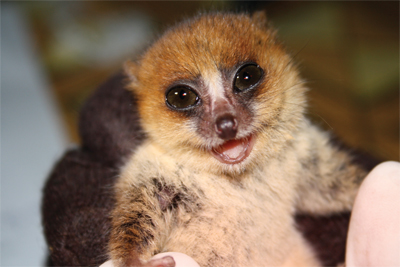 The majority of mouse lemurs are docile and tend to keep these personality traits through their lives. Courtesy of Sarah Zohdy
The majority of mouse lemurs are docile and tend to keep these personality traits through their lives. Courtesy of Sarah Zohdy
Wright, who serves as the director of Centre ValBio and spends six to eight months onsite each year, first traveled to Madagascar in 1986 in search of the greater bamboo lemur. After finding the lemur and discovering additional species, Wright helped establish Ramonafana National Park in the early 1990s to protect the animals’ natural habitat. She went on to found Centre ValBio in 2003.
In 2012, Krasnow, who met Wright in 2010, helped her establish a new 15,000-square-foot building at the station with modern molecular biology labs, housing areas for staff and visiting researchers, high-speed internet and the only bio-safety level 2 lab on Madagascar outside of the capital city. The center employs more than 70 Malagasy, and has dedicated outreach groups focused on the relationship between the local populations and the rainforest as well as the residents’ health and living conditions.
When Zohdy first traveled to the island in 2007 to examine the effects of aging in wild mouse lemurs, she was a graduate student working alongside Wright and her colleagues, with whom she continues to collaborate.
To assess the lemurs, the researchers capture them with live traps baited with pieces of banana. “Mouse lemurs absolutely love banana,” Zohdy said. As pollinators in their ecosystem, the mouse lemurs largely feed on fruits and nectar, making bananas a natural fit. “We set the traps out for a few hours, capture the lemurs and do our assessments, and then release them on the same branch that we captured them on a few hours later.”
The assessments are gentle but thorough: Examine the mouse lemurs for phenotypic traits, measure weight, take small skin and blood samples, collect fecal samples for parasite analysis, collect a small amount of hair for dietary analysis through isotopes, and subject the nocturnal critters to a behavioral assay to determine whether they’re aggressive or docile. Most importantly, the researchers insert a microchip smaller than a grain of rice into each lemur so they can identify individuals that are recaptured over the years. The researchers also create dental molds of the lemurs, which allow them to estimate an individual lemur’s age during its first assessment.
“Today, we still have several mouse lemurs that were initially captured in 2003,” Zohdy said. “Fun fact — about 80 percent of the mouse lemurs are docile most of the time, and they tend to keep those behavioral types or personalities consistent over the years.”
Driving across Madagascar’s rugged terrain can eat up the better part of the day — the drive between Centre ValBio and Antananarivo, the nation’s capital and location of its leading university, the University of Antananarivo, usually takes between 10 and 12 hours, Zohdy said. During these drives in 2010, she and Krasnow began to discuss using wild mouse lemurs as a study population, rather than bringing the animals back to the labs at Stanford and creating knockouts, “something that took decades with the mouse and would probably take 50 or 60 years with the mouse lemur,” she said.
Lemurs in the lab
Much of the laboratory research involving mouse lemurs takes place at the world’s largest captive mouse lemur colony in Brunoy, France.
“They’re kept in a beautiful chateau outside of Paris,” said Wright, who first traveled to the facility in 2003 with her student Caitlin Karanewsky, now a postdoctoral fellow who has been playing a leading role along with Zeph Pendleton in the mouse lemur project in Krasnow’s lab. “It’s absolutely gorgeous, and you don’t even realize that it’s a research lab until you get close enough to smell it.”
The lab, which was led for many years by Martine Perret and is now run by Fabienne Aujard and owned by France’s National Center for Scientific Research and National Museum of Natural History, is home to about 500 of the nocturnal animals living in large, light-controlled cages that make observing them during daylight hours easier for the scientists. After visiting the lab, Wright applied for and received a grant from the National Science Foundation to fund the initial capture-and-microchip work in Madagascar.
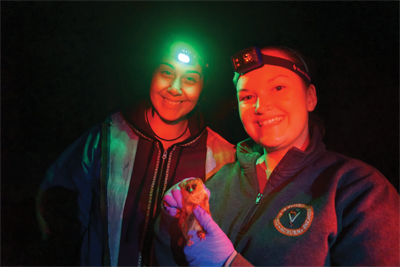 Out in the field, Sarah Zohdy (left) and Victoria Crabtree (right) perform physical examinations on multiple mouse lemurs each night. Courtesy of Gabriel Andrle
Out in the field, Sarah Zohdy (left) and Victoria Crabtree (right) perform physical examinations on multiple mouse lemurs each night. Courtesy of Gabriel Andrle
Zohdy became interested in field research involving mouse lemurs after reading a paper published by Aujard’s group that discussed the animals’ tendency to experience Alzheimer’s-like neurodegeneration in captivity at about 3 to 4 years old, in addition to losing their sense of smell and devel oping cataracts.
During her first trip to Madagascar as a graduate student, Zohdy examined dozens of wild mouse lemurs for symptoms similar to Alzheimer’s disease. While she, Wright and colleagues found that wild mouse lemurs lacked the debilitating hallmarks of age neurodegeneration, they weren’t able to rule out Alzheimer’s entirely due to the difficulty in diagnosing the disease without an autopsy or MRI.
“Most mouse lemurs in captivity past the age of 4 are considered elderly, and in the wild we were capturing 8-, 9- and 10-year olds,” Zohdy said. “We didn’t see any of the visible symptoms of senescence, but the question of whether or not they have the brain plaques is still kind of up in the air.”
The largest mouse lemur colony in the United States is at the Duke Lemur Center in Durham, North Carolina. When evolutionary biologist Anne D. Yoder took over as the director of the center in 2006, mouse lemurs no longer were being kept at the center, so the initial specimens had to be brought over from the colony in France.
“I was especially concerned given the research that had been coming out of France…relating to mouse lemurs as models for Alzheimer’s disease,” Yoder said. “I knew that an important component of our research enterprise would have to be to have a mouse lemur colony that could be studied for that purpose.”
The Durham center, ensconced in 80 acres of native deciduous forest, consists of eight natural habitat enclosures and two large indoor-outdoor buildings. While many of the 18 species housed there are allowed to range freely in the forests and along the pathways that lead back into the indoor habitats, mouse lemurs must be kept inside.
Yoder is fond of saying, “Do unto the lemurs as you would unto yourself.” All the research conducted at the center is founded on a strictly “do-no-harm” policy. The center acts as a hub of resources for researchers who need to acquire blood samples or use veterinary facilities.
In Yoder’s collaborative efforts with Krasnow, whom she met in 2011, she has brought her noninvasive approach to studying the lemurs to the forefront.
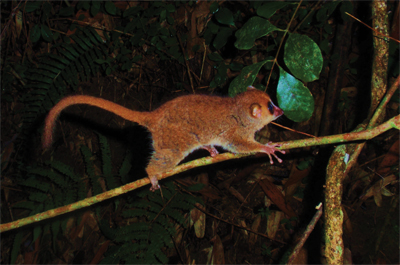 In the wild, mouse lemurs have been found to live upwards of 13 years. Courtesy of Sarah Zohdy
In the wild, mouse lemurs have been found to live upwards of 13 years. Courtesy of Sarah Zohdy
Krasnow and his colleagues hope that by sequencing the genomes and cataloguing the physical phenotypes of the millions of mouse lemurs on Madagascar, they will be able to identify and assess all of the animals’ naturally occurring mutations and the impact these have on the lemurs’ biology, behavior, diseases and ecology, “Individual humans have about 100 null mutations, so, if we could study the entire mouse lemur population and they have a similar number of null mutations, we wouldn’t necessarily need to create knockouts,” Zohdy said.
Moving beyond knockouts
In 2011, Krasnow convened a meeting of about 40 mouse lemur biologists and scientists with experience in designing transgenic mice models at the Howard Hughes Medical Institute’s Janelia Research Campus in Ashburn, Virginia, then known as Janelia Farm Research Campus. Here, the researchers formally settled on eschewing large-scale knockout lemur colonies in favor of studying the wild populations.
“I knew enough about transgenic models to know that it would not be compatible with the conservation mission and ethics of endangered species,” Yoder said. “I could see peoples’ faces sort of dropping as the transgenic people were talking about how you create a transgenic model.” A rift was averted, however, when Jeff Rogers from Baylor College of Medicine’s Human Genome Sequencing Center proposed creating an updated reference sequence of the mouse lemur genome to match to the phenotypic data that were being collected in the field. “He made this beautiful speech about the power of genomics and how that would obviate the need for sacrificing hundreds and hundreds of mouse lemurs.”
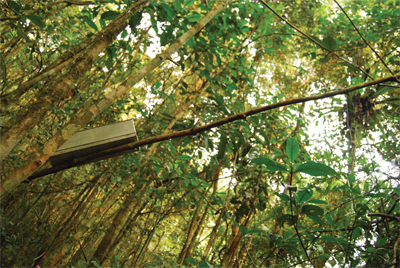 The metal boxes that are used to capture mouse lemurs are baited with bananas, for which the lemurs will often be waiting at the ready. To avoid repeat captures, the traps are rotated through different locations. Courtesy of Sarah Zohdy
The metal boxes that are used to capture mouse lemurs are baited with bananas, for which the lemurs will often be waiting at the ready. To avoid repeat captures, the traps are rotated through different locations. Courtesy of Sarah Zohdy
While still in the auditorium, Yoder was able to contact a colleague who had a preserved collection of mouse lemur tissues that had been used to create the first iteration of the genome roughly a decade prior.
With the tissues secured, she and Rogers formed a collaborative group on the spot. That group published an updated assembly of the mouse lemur genome in the journal BMC Biology this month.
The researchers assembled the genome with a bio-nano optical map, which visualizes how the sequences are aligned, organized and ordered along large scaffolds.
“Having a genome that’s annotated with robust and high-quality long scaffolds as a resource is absolutely incredible,” said Peter Larsen, the first author on that paper. “We can now peer into this organism in ways that we never imagined before.”
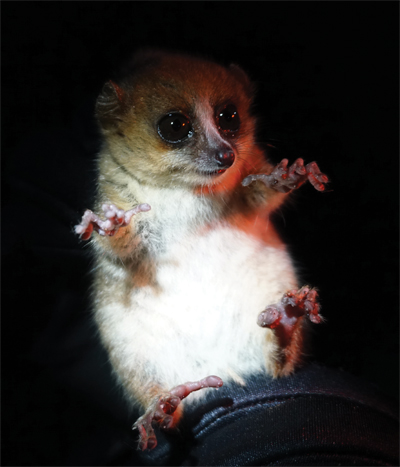 Mouse lemurs are nocturnal and subsist largely on fruit and pollen.Courtesy of Sarah Zohdy
Mouse lemurs are nocturnal and subsist largely on fruit and pollen.Courtesy of Sarah Zohdy
Out of the classrooms
and into the trees
While Yoder, Rogers and their collaborators begin to probe the genome for genes shared by the lemurs and humans, Krasnow, Zohdy and their colleagues, including those in Madagascar, are enlisting local high school, college and graduate students in the daunting task of cataloguing, the lemurs’ traits.
“We need an even larger research community,” Krasnow said. “We need to screen many thousands or even millions of mouse lemurs to do basically the largest systematic screen that has ever been done in a mammalian system.”
Inside of the laboratories at ValBio, Krasnow and his colleagues are bringing the lively study of mouse lemurs to the scientific education programs of Madagascar.
“By studying the natural populations, we have the potential to build scientific capacity in Madagascar and bring world-renowned scientists there,” Zohdy said.
“So instead of taking this knowledge away, we can bring it there and help this developing nation come into the future and really accelerate their science programs.”To this end, Krasnow teaches a weeklong workshop for students from Malagasy high schools, from the University of Antananarivo and from classes taught by Hanta Rasamimanana at École Normale Supérieure, the university’s training arm for professionals. The workshop introduces participants to professors and familiarizes them with genetics, genomics and how both can be applied to the tiny mammals living around them.
“By bringing teachers and professors to these workshops, he’s really scaling up the scope of this,” Zohdy said. “It’s no longer just training one or two individual Malagasy graduate students in the science of genomics, but training an entire generation.”
To this end, Krasnow partnered with Stanford biological engineer and 2016 MacArthur Fellow Manu Prakash to implement the inventor’s ultra-cheap paper microscopes, Foldscopes, as part of a wider push for citizen science in the Malagasy education system.
“The kids are absolutely loving it,” Wright said. “I’m sure there’s going to be a whole generation of people going into science in Madagascar because of Mark and his project.”
Enjoy reading ASBMB Today?
Become a member to receive the print edition four times a year and the digital edition monthly.
Learn moreGet the latest from ASBMB Today
Enter your email address, and we’ll send you a weekly email with recent articles, interviews and more.
Latest in Science
Science highlights or most popular articles

Using DNA barcodes to capture local biodiversity
Undergraduate at the University of California, Santa Barbara, leads citizen science initiative to engage the public in DNA barcoding to catalog local biodiversity, fostering community involvement in science.

Targeting Toxoplasma parasites and their protein accomplices
Researchers identify that a Toxoplasma gondii enzyme drives parasite's survival. Read more about this recent study from the Journal of Lipid Research.

Scavenger protein receptor aids the transport of lipoproteins
Scientists elucidated how two major splice variants of scavenger receptors affect cellular localization in endothelial cells. Read more about this recent study from the Journal of Lipid Research.

Fat cells are a culprit in osteoporosis
Scientists reveal that lipid transfer from bone marrow adipocytes to osteoblasts impairs bone formation by downregulating osteogenic proteins and inducing ferroptosis. Read more about this recent study from the Journal of Lipid Research.

Unraveling oncogenesis: What makes cancer tick?
Learn about the ASBMB 2025 symposium on oncogenic hubs: chromatin regulatory and transcriptional complexes in cancer.

Exploring lipid metabolism: A journey through time and innovation
Recent lipid metabolism research has unveiled critical insights into lipid–protein interactions, offering potential therapeutic targets for metabolic and neurodegenerative diseases. Check out the latest in lipid science at the ASBMB annual meeting.

